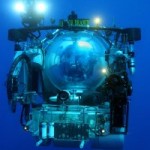
One of the challenges of doing research in the deep-sea is the expense of getting down there and staying down there long enough (i.e., needing ships, ROVs, and submersibles). One way around that is to leave sensors on the bottom to collect data even when nobody is around. However, then you run into a power supply problem–can’t exactly run out and change the batteries every couple of weeks. The solution? Microbial fuel cells. Clare Reimer’s group at OSU have been working on seafloor fuel cells that exploit the naturally-occurring bacteria and geochemistry to generate power for deep-sea sensors. However, like graduate students, microbes work best when bribed with food…and deep-sea sediments can be poorly stocked with organic matter, limiting how long the stationary fuel cells could function. Bruce Logan from Penn State has recently done some experiments where the fuel cell anode was padded with nutritious bacterial munchies to encourage the microbial workforce. What is the deep-sea microbial equivalent of Doritos? Chitin. Since chitin is common to the deep-sea in the form of crustacean shells, there are lots of naturally-occurring bacteria capable of digesting it. Experiments revealed that chitin was more effective than cellulose as a ‘booster’ for microbial batteries. In your face, Energizer Bunny!

Seafloor fuel cell: Clare Reimers
Image credits:Bacteria in power plant: Science News






“However, like graduate students, microbes work best when bribed with food”
They work better when bribed with beer. :-)